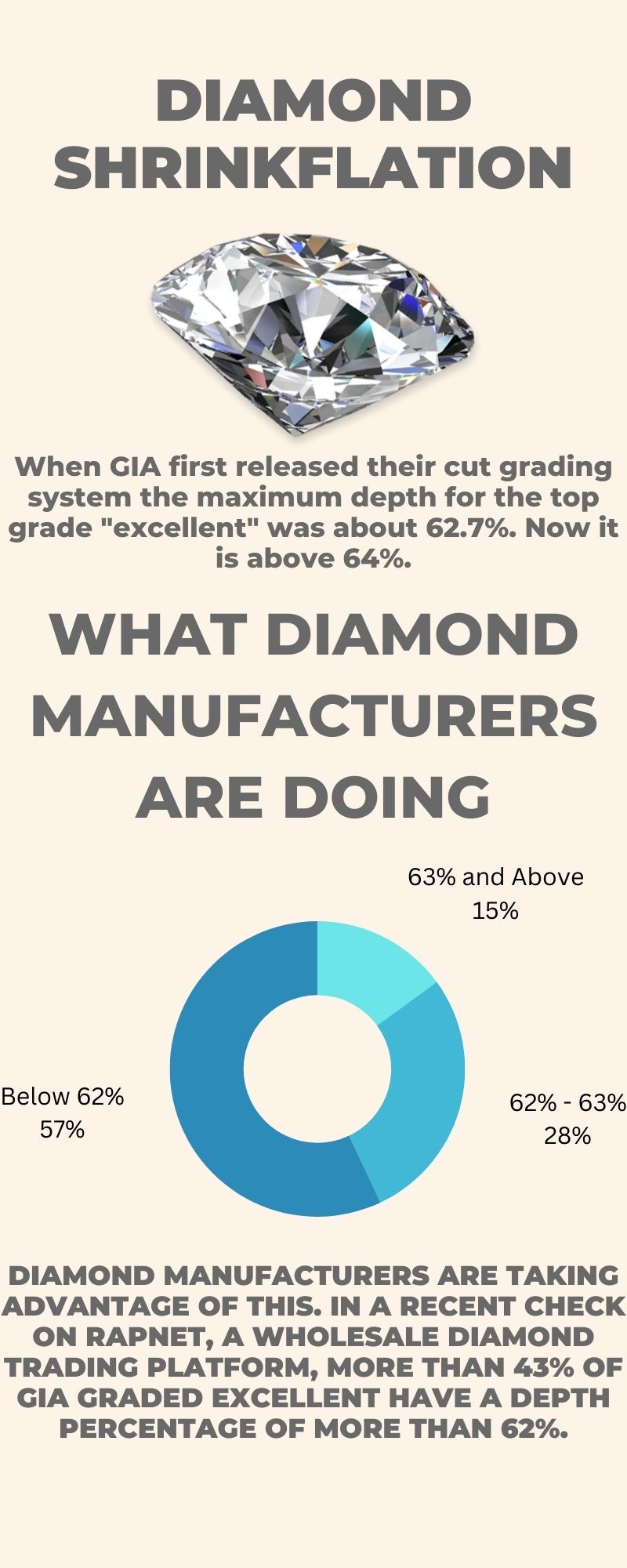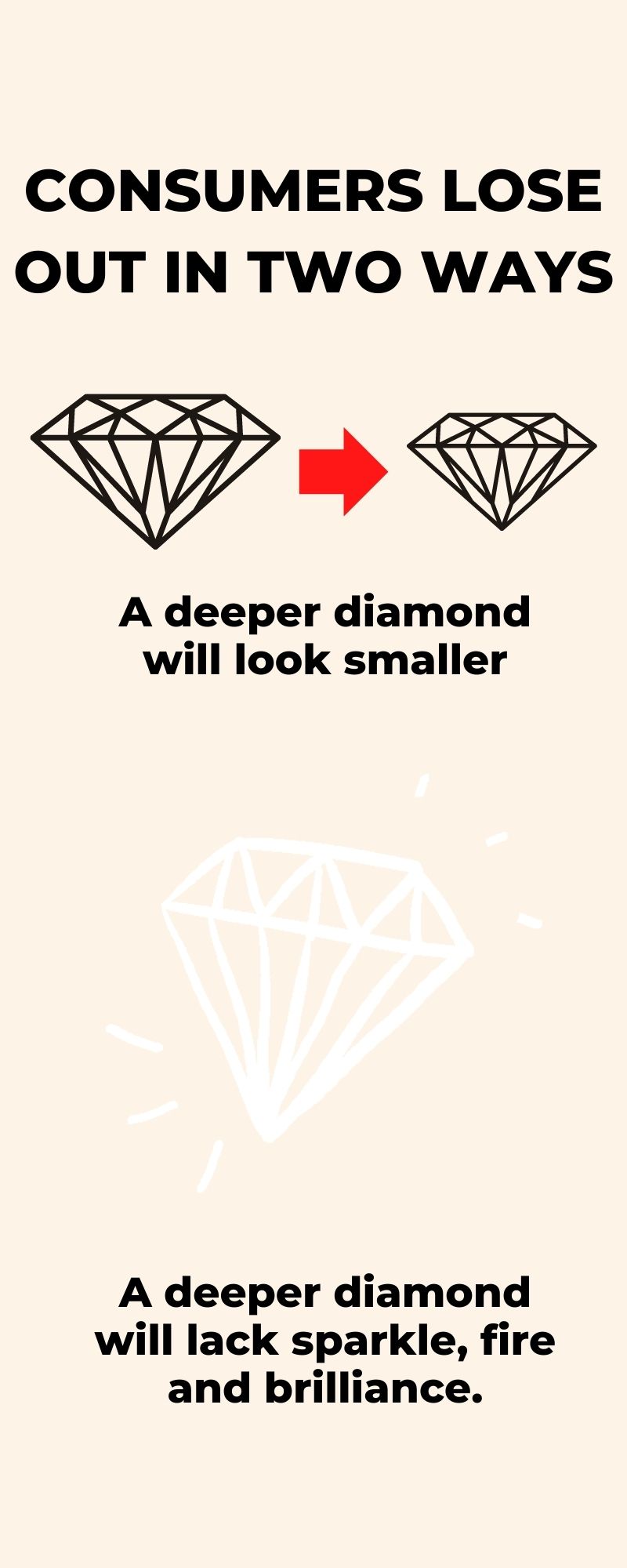So if you’re unfamiliar with the term “shrinkflation”, it refers to a product being reduced in size whilst the amount being charged staying the same. A good example is a bag of potato chips weighing 200 grams suddenly going down to 180 grams and the price staying the same. Whilst this may be good for peoples’ waistlines, the same has been happening in the diamond industry for the best part of the past two decades.
Whilst you may think that since diamonds are priced based on their quality and weight, and not sold in packages, that diamonds are immune to shrinkflation. However, a diamond’s value is judged primarily on The 4Cs – being carat weight, colour, clarity and cut. Carat weight, being an objective measure of weight, has and always will remain constant. Likewise, a diamond’s colour grade is fairly objective. Sure, there may be disputes around colour grading for individual diamonds, but given the same colour scale is used and master stones are properly graded, colour grading has remained fairly consistent over the years.
The shrinkflation problem in diamonds has two factors. Firstly, I and many others in the industry believe that clarity grading have been significantly loosened over the past 20 years. This leads to diamonds being graded one grade up than what they should be. For example, a diamond being graded a VS2 instead of an SI1. There used to be a saying in the industry that an SI2 or above was definitely “eye-clean”, meaning you couldn’t see any inclusions from the top with your naked eye. About 15 or so years ago, these standards changed when all labs started grading stones that weren’t eye-clean as SI1 or SI2, so only VS2s and above were guaranteed to be eye-clean. Nowadays, even some VS2s are not eye-clean.
However, the second and far more serious factor is that of cut grading. Whilst all grading labs have different cut grading scales, the GIA has loosened their top cut grade, which is “excellent”, so significantly that it is now virtually meaningless.
Back in 2005, GIA introduced their cut grading system and whilst it wasn’t perfect, it was a good step forward for the GIA, which had pretty much been ignoring cut quality up until that point. It is important to note that around this time, there was already a lot of research being done by the likes of Garry Holloway and The American Gem Society into diamond cut, so right from the outset, the GIA cut grading system seemed somewhat inferior. In addition to this, companies like Gemex produced machines that directly measured a diamond’s light performance.
Fast forward to 2022, and GIA dominates diamond grading and is seen as the gold standard around the world. In fact, doing a quick search on the diamond market, GIA account for upwards of 95% of the high quality diamonds above 1ct being sold on the wholesale market. However, that dominance is surely not due to the GIA’s cut grade.
Back when the GIA’s cut grading system was first released, there was a fair bit of criticism from some areas of the diamond industry due to deeper diamonds being graded as “excellent”, especially from Garry Holloway and his friends at Pricescope. Some of this criticism was fair, and some of it was a little bit over-dramatic, or even used to shill diamonds from Pricescope vendors. However, we have come to a point that GIA’s brazen loosening of their cut grading standards has become almost ridiculous. Whilst I don’t have exact numbers, when the GIA first released their cut grade, the deepest diamond that could earn the top grade of “excellent” would have a depth percentage of around 62.7%. Now, with just a quick search, I found that GIA now grade diamonds with a 64.2% depth as “excellent”, which is their top cut grade!
Of course, diamond manufacturers are responding accordingly and cutting diamonds according to the updated GIA cut grading system. This no doubt increases yields significantly, leading to more profit for the manufacturer, and, in a world where high quality diamonds are essentially commoditised, manufacturers can get away with it without many noticing.

The loosening of GIA’s cut grade standards essentially means that diamond consumers are being hit in two ways:
- The GIA certified “excellent” cut diamond they buy will face up smaller. For example, a 1ct will look like a 0.90ct.
- Because of the deeper cut, it is likely a significant amount of fire and brilliance is lost.

However, as a consumer, there are two simple ways of beating “diamond shrinkflation”:
- Pay attention to the depth percentage of the diamond and reject any stupidly deep stones (eg: 64.2% depth) graded as “excellent” cut.
- Always buy a diamond from a retailer who has the proper equipment to grade light performance as the GIA “excellent” grade is now a joke.